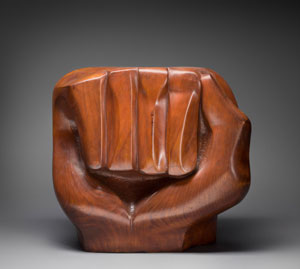5.21.25 — Unforgiving
Nancy Elizabeth Prophet set high standards—for herself, for art, and for America. Her show’s very title sounds unrelenting, and her chosen medium looks unyielding as well.
“I Will Not Bend an Inch,” the Brooklyn Museum proclaims, and she offers nothing as malleable as clay. The museum sets out a shelf of her tools, through July 13, and one can feel them cutting into hard and soft wood alike.  Her subjects, like a Congolese and a Cossack, look unforgiving as well. Do not be surprised if they turn out to resemble the artist.
Her subjects, like a Congolese and a Cossack, look unforgiving as well. Do not be surprised if they turn out to resemble the artist.
Her very name puts those who encounter her on the spot. It is too late to change what an Old Testament prophet has seen. Her work looks like nothing so much as the chronicle in wood by Elizabeth Catlett at the Brooklyn Museum just months before. All it lacks is the knockout punch from Catlett’s larger than life wood fist. While Catlett lived to see the civil rights movement and had relatives who knew slavery, Prophet’s time on earth, from her birth in 1890, pretty much coincides with a history of modern art. Now if only it felt as free.
Her sculpture stands in one long line at the center of the room, and the museum gives her a time line as well, all but devoid of incident. Mostly she went to the Rhode Island School of Design (or RISD) and made art. She is, though, is not so easy to pin down. Just by gathering her sculpture into a collective history, the display literally takes them off their pedestals. Watercolors render nature sparely, in casual loops, with soft colors for architecture—and one set of towers sways in the wind. Like it or not, it bends more than an inch.
If she ever drew a line in the sand, she stepped right over it. Her busts are not just women, not even close. Like the Cossack, they are also not just black. Their anonymous faces have a particular debt to classical art. In her hands, it becomes be hard to tell the cloaks of ancient Roman statuary from a woman’s dress. Faces are themselves of uncertain ancestry and race, and titles speak of poverty and youth.
Are they gods, emperors, or African American labor? For Prophet, the categories run together, and African Americans have earned their place in history. Domestic labor and everyday human connections bring her closer to the gods. She was herself of mixed ancestry, with a black mother and Native American father, and the show identifies her as (ready?) Afro Indigenous. The closer her busts come to self-portraits, the lighter their hair. The more, too, they resemble masks.
She took an interest in diversity in her life as well. She taught at Spelman, the historically black college in Atlanta, and went to Paris to see art. Critics associate her with the “New Negro” movement, a coinage by Alain Locke, theorist of the Harlem Renaissance. That tight row of sculpture brings out the breadth an contradictions of race in America. All face out, in one direction or other, with much the curled lips and firm stares. They have the room outside Judy Chicago and her Dinner Party, an icon of feminism with its own love of goddesses.
Prophet changed the spelling of her name from Profitt to take responsibility for what she saw, with cause for outrage along with pride and hope. Has she entered history, or can she return to a sideline that Modernism had outgrown? For William Butler Yeats, art always takes the long view. “Though Hamlet rambles and Lear rages, / And all the drop scenes drop at once / Upon a hundred thousand stages, / It cannot grow by an inch or an ounce.” It may yet, though, bend an inch.